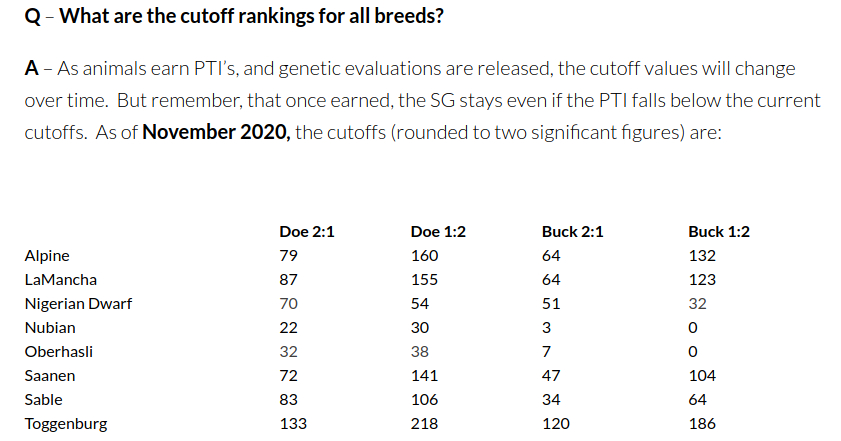Superior Genetics



PTI is a ranking that combines milk test data and linear appraisal data into an index where 0 equals the breed average, positive numbers are above average, and negative numbers are below average scores. Negative numbers aren’t necessarily bad because the average is only the average of goats who participate in milk test and linear appraisal. These tend to be goats in herds focused on performance and improving the breed. The best of the best. Having a negative PTI is better than no PTI at all in my opinion!
To get a PTI number, a doe needs to have a linear appraisal score and be on milk test through at least 40 days fresh with at least one other herdmate on test at the same time. Comparing the performance of herdmates is important because herd management and local climate have a large effect on production. Milk test data up to and including a doe’s 6th lactation is used. All linear appraisal scores are used. It is possible for a doe to get a PTI without being on milk test if many immediate relatives have milk test data.
There are two forms of PTI:
Important to Note: PTI numbers are NOT based solely on a goat’s own milk production and linear appraisal scores. The production and scores of all of its immediate relatives with data on file are used in the calculations. A PTI number reflects the genetic potential of a goat based on both its own performance and that of its immediate family members.
The average genetic value for a certain trait that an animal transmits to its offspring. Again, this is not based on just that goat’s data. The data from all of its immediate relatives are also used in the calculations.
Production:
Type:
It’s a method to combine volume and butterfat percentage into one number to make comparisons between animals easier. Correcting to 4% is common practice and the formula is: (0.4 x pounds of milk) + (15 x pounds of fat). For example, if Goat A produces 1,000 pounds of 5% milk (50 pounds of fat) and Goat B produces 1,500 pounds of 3% milk (45 pounds of fat) and we “fat corrected” their milk to 4%, Goat A would have 1,150 pounds and Goat B would have 1,275 pounds.